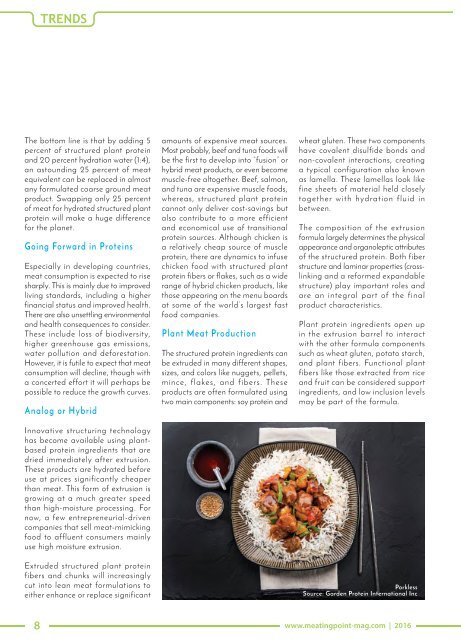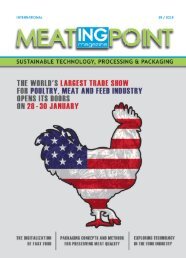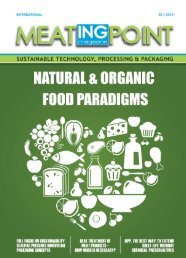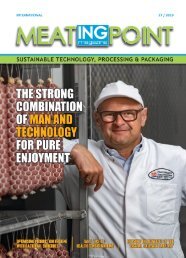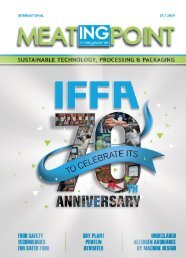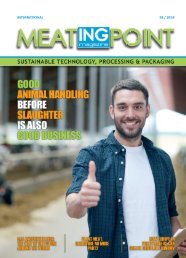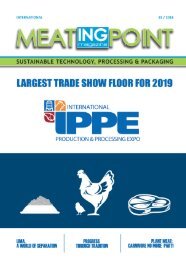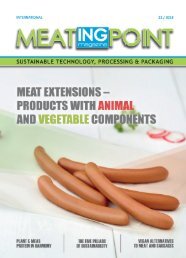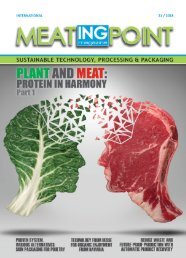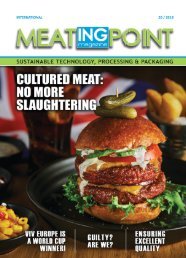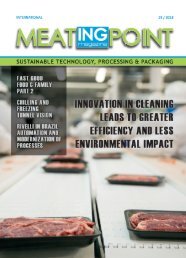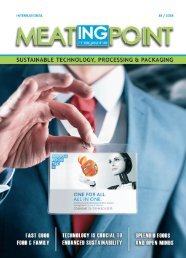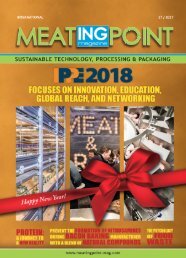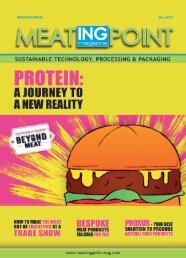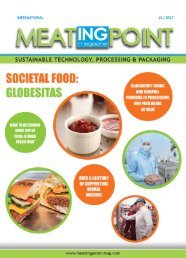MEATing POINT Magazine: #07/ 2016
Create successful ePaper yourself
Turn your PDF publications into a flip-book with our unique Google optimized e-Paper software.
TRENDS<br />
The bottom line is that by adding 5<br />
percent of structured plant protein<br />
and 20 percent hydration water (1:4),<br />
an astounding 25 percent of meat<br />
equivalent can be replaced in almost<br />
any formulated coarse ground meat<br />
product. Swapping only 25 percent<br />
of meat for hydrated structured plant<br />
protein will make a huge difference<br />
for the planet.<br />
Going Forward in Proteins<br />
Especially in developing countries,<br />
meat consumption is expected to rise<br />
sharply. This is mainly due to improved<br />
living standards, including a higher<br />
financial status and improved health.<br />
There are also unsettling environmental<br />
and health consequences to consider.<br />
These include loss of biodiversity,<br />
higher greenhouse gas emissions,<br />
water pollution and deforestation.<br />
However, it is futile to expect that meat<br />
consumption will decline, though with<br />
a concerted effort it will perhaps be<br />
possible to reduce the growth curves.<br />
Analog or Hybrid<br />
Innovative structuring technology<br />
has become available using plantbased<br />
protein ingredients that are<br />
dried immediately after extrusion.<br />
These products are hydrated before<br />
use at prices significantly cheaper<br />
than meat. This form of extrusion is<br />
growing at a much greater speed<br />
than high-moisture processing. For<br />
now, a few entrepreneurial-driven<br />
companies that sell meat-mimicking<br />
food to affluent consumers mainly<br />
use high moisture extrusion.<br />
Extruded structured plant protein<br />
fibers and chunks will increasingly<br />
cut into lean meat formulations to<br />
either enhance or replace significant<br />
amounts of expensive meat sources.<br />
Most probably, beef and tuna foods will<br />
be the first to develop into “fusion” or<br />
hybrid meat products, or even become<br />
muscle-free altogether. Beef, salmon,<br />
and tuna are expensive muscle foods,<br />
whereas, structured plant protein<br />
cannot only deliver cost-savings but<br />
also contribute to a more efficient<br />
and economical use of transitional<br />
protein sources. Although chicken is<br />
a relatively cheap source of muscle<br />
protein, there are dynamics to infuse<br />
chicken food with structured plant<br />
protein fibers or flakes, such as a wide<br />
range of hybrid chicken products, like<br />
those appearing on the menu boards<br />
at some of the world’s largest fast<br />
food companies.<br />
Plant Meat Production<br />
The structured protein ingredients can<br />
be extruded in many different shapes,<br />
sizes, and colors like nuggets, pellets,<br />
mince, flakes, and fibers. These<br />
products are often formulated using<br />
two main components: soy protein and<br />
wheat gluten. These two components<br />
have covalent disulfide bonds and<br />
non-covalent interactions, creating<br />
a typical configuration also known<br />
as lamella. These lamellas look like<br />
fine sheets of material held closely<br />
together with hydration fluid in<br />
between.<br />
The composition of the extrusion<br />
formula largely determines the physical<br />
appearance and organoleptic attributes<br />
of the structured protein. Both fiber<br />
structure and laminar properties (crosslinking<br />
and a reformed expandable<br />
structure) play important roles and<br />
are an integral part of the final<br />
product characteristics.<br />
Plant protein ingredients open up<br />
in the extrusion barrel to interact<br />
with the other formula components<br />
such as wheat gluten, potato starch,<br />
and plant fibers. Functional plant<br />
fibers like those extracted from rice<br />
and fruit can be considered support<br />
ingredients, and low inclusion levels<br />
may be part of the formula.<br />
Porkless<br />
Source: Garden Protein International Inc<br />
8 www.meatingpoint-mag.com | <strong>2016</strong>


